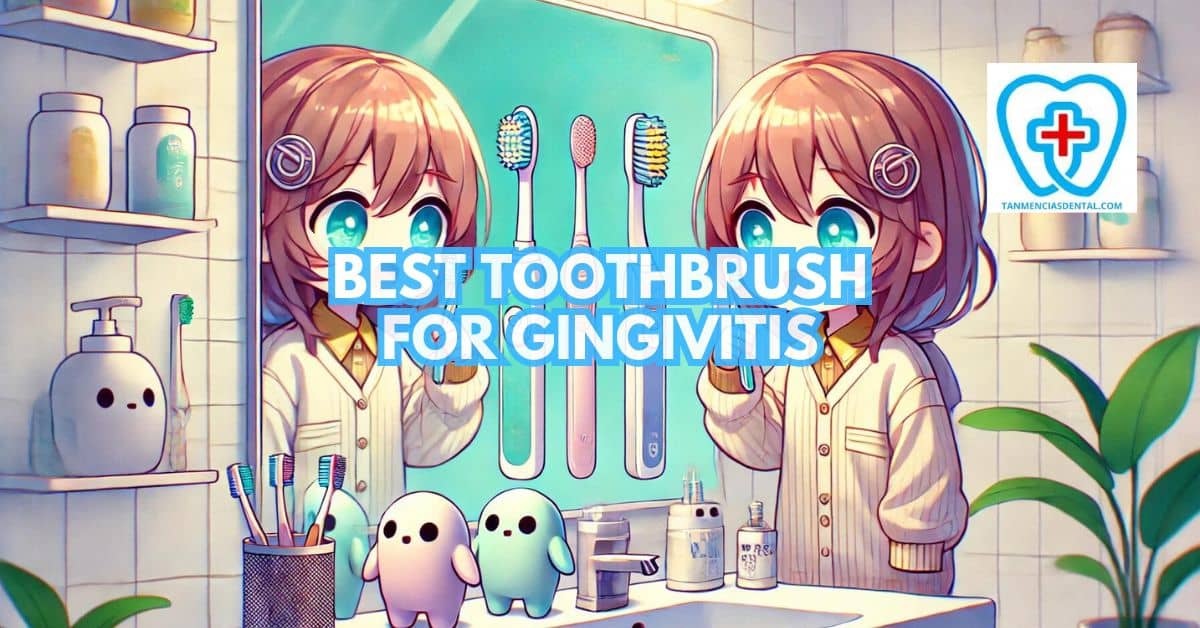Gingivitis is a mild form of gum disease that results from the accumulation of plaque on the teeth.
Early symptoms include redness, swelling, and bleeding of the gums, particularly during brushing or flossing.
If not treated, gingivitis can lead to more severe periodontal diseases, which can cause tooth loss.
Good oral hygiene, including regular brushing with the right toothbrush, plays a crucial role in preventing and managing gingivitis.
This guide will help you choose the best toothbrush to maintain your gum health and prevent the progression of gingivitis.
1. What Is Gingivitis and Why Is Oral Hygiene Important?
Gingivitis is primarily caused by bacterial plaque that irritates the gums and leads to inflammation.
Oral hygiene is vital in removing plaque and preventing it from hardening into tartar, which can exacerbate gum disease.
Regular brushing and flossing are essential in keeping the gums healthy and avoiding the progression of gingivitis to more serious conditions.
If left untreated, gingivitis can lead to receding gums, deep pockets around the teeth, and eventually tooth loss.
Choosing the right toothbrush is an important step in maintaining proper oral hygiene and protecting your gums.
🦷 Can You Use Mouthwash With Braces?
2. Why Choosing the Right Toothbrush Matters for Gingivitis
Selecting an appropriate toothbrush is crucial for those dealing with gingivitis because it can make a significant difference in oral health.
The right toothbrush can effectively remove plaque without causing irritation to already sensitive gums.
A poorly chosen toothbrush, on the other hand, can fail to clean adequately or even worsen gum irritation, leading to further complications.
The ideal toothbrush for gingivitis should have soft bristles and a small head to access difficult areas.
By investing in the right toothbrush, you can better manage and even reverse the early stages of gum disease.
🦷 How Often Should You Brush Your Teeth With Baking Soda?
3. Soft vs. Medium Bristles: Which Is Better for Gingivitis?
Soft-bristled toothbrushes are generally recommended for individuals with gingivitis because they are gentle on inflamed gums.
Medium-bristled toothbrushes, while effective for some people, can be too abrasive for those with gum disease, potentially leading to further irritation or bleeding.
Soft bristles can effectively remove plaque from the gum line without causing damage to delicate gum tissue.
For those experiencing significant gum sensitivity, ultra-soft bristles might be an even better choice.
It’s important to select a toothbrush that cleans thoroughly without causing additional discomfort or harm.
🦷 How to Budget for Your Next Dental Checkup and Cleaning Cost
4. Manual vs. Electric Toothbrushes: What’s Best for Your Gums?
When considering a toothbrush for gingivitis, the choice between manual and electric toothbrushes can be significant.
Electric toothbrushes are often favored because they provide consistent brush strokes and can be more effective at removing plaque with less effort.
The oscillating or vibrating motion of an electric toothbrush helps to clean along the gum line and between teeth more thoroughly.
However, a manual toothbrush can also be effective if used correctly with proper brushing techniques, such as brushing for two minutes and focusing on all areas of the mouth.
The key is choosing a toothbrush that you will use consistently and comfortably, ensuring that your gums receive the care they need.
🦷 Why Is Dental Work So Expensive? Comparing Costs Across Different Procedures
5. Choosing the Right Brush Head Size and Shape for Effective Cleaning
The size and shape of a toothbrush head are important factors in ensuring a thorough clean, especially when dealing with gingivitis.
A smaller brush head can reach areas that are difficult to clean, such as the back teeth and along the gum line, which is crucial for preventing plaque buildup.
Brush heads that are rounded or have tapered bristles can also help in cleaning hard-to-reach spots without causing gum irritation.
Choosing the right brush head allows for more precise brushing, ensuring that all areas of the mouth are effectively cleaned.
This can help in reducing the symptoms of gingivitis and maintaining overall oral health.
🦷 Are Dentists Rich? Unveiling the Truth Behind the Smiles and Stethoscopes
6. How an Ergonomic Handle Can Improve Your Brushing Routine
An ergonomic toothbrush handle can make a significant difference in your daily brushing routine, especially if you have difficulty maintaining the correct grip or angle while brushing.
A well-designed handle allows you to hold the toothbrush comfortably and securely, which can lead to better control over brushing pressure and movement.
This is particularly important for those with gingivitis, as too much pressure can harm sensitive gums.
Additionally, ergonomic handles often reduce hand fatigue, making it easier to brush for the recommended two minutes.
Investing in a toothbrush with an ergonomic handle can lead to more effective brushing and better gum health.
🦷 Can Baking Soda Remove Tartar and Improve Your Oral Health?
7. When and Why to Replace Your Toothbrush for Optimal Gum Health
Regularly replacing your toothbrush is essential for maintaining gum health, especially when dealing with gingivitis.
Over time, bristles become frayed and less effective at cleaning, which can lead to plaque buildup and worsening of gum disease.
Dentists recommend replacing your toothbrush every three to four months, or sooner if the bristles show signs of wear.
A worn toothbrush not only loses its cleaning ability but can also harbor bacteria that may contribute to oral health issues.
Keeping your toothbrush in good condition ensures that it remains an effective tool in your fight against gingivitis.
🦷 Can Electric Toothbrushes Damage Teeth?
8. Key Features to Look for in a Toothbrush for Gingivitis
When selecting a toothbrush for gingivitis, there are several key features to consider that can make a significant difference in your oral health.
Soft bristles are a must, as they gently clean the gums without causing further irritation.
A small, rounded brush head is also important, as it allows you to clean around each tooth and along the gum line more effectively.
Look for toothbrushes with angled or multi-level bristles, which can reach deeper between teeth and under the gum line where plaque tends to accumulate.
Additionally, a comfortable, non-slip handle can enhance your brushing experience, making it easier to use the toothbrush correctly and consistently.
🦷 Exploring the Benefits of Rinsing With Salt Water for Your Oral Health
9. Expert Recommendations: What Dentists Say About Toothbrushes for Gingivitis
Dentists often emphasize the importance of using a toothbrush with soft bristles to prevent further irritation to the gums.
They also recommend electric toothbrushes for their ability to deliver consistent, thorough cleaning, which can be particularly beneficial for individuals with gingivitis.
Another common piece of advice from dentists is to choose a toothbrush with a small head, allowing for better access to all areas of the mouth.
Some experts suggest looking for toothbrushes with pressure sensors, especially in electric models, to avoid brushing too hard, which can damage the gums.
Following these expert recommendations can guide you in choosing a toothbrush that supports your gum health and aids in the prevention of gingivitis.
🦷 Why Do Gums Bleed When Brushing Teeth? Common Causes and Solutions
10. Finding the Right Toothbrush for Your Budget: What to Consider
Choosing the right toothbrush doesn’t have to break the bank; there are options available for every budget.
While high-end electric toothbrushes offer advanced features like timers and pressure sensors, many affordable manual toothbrushes can still provide effective cleaning if used properly.
When working within a budget, focus on essential features like soft bristles and the appropriate brush head size.
It’s also worth considering subscription services that offer regular delivery of replacement heads or brushes, which can be more cost-effective in the long run.
Balancing cost with the quality and features of the toothbrush will help you maintain your gum health without overspending.
🦷 Tips for Optimal Dental Care While You Sleep
👨⚕️ Conclusion
Selecting the best toothbrush for gingivitis is a crucial step in maintaining and improving your gum health.
By focusing on key factors such as bristle softness, brush head size, and ergonomic design, you can ensure that your daily brushing routine effectively targets plaque and protects your gums.
Listening to expert advice and considering your budget will further guide you in making an informed decision.
Remember, a well-chosen toothbrush not only helps in managing gingivitis but also plays a vital role in preventing its progression to more severe gum diseases.
With the right tools and a consistent routine, you can take control of your oral health and keep your gums healthy.
😁 Self Promotion
At Tan-Mencias Dental Clinic in Parang, Marikina City, we are dedicated to providing top-notch dental care with a personal touch.
Our friendly team is here to help you achieve a healthy, beautiful smile in a comfortable and welcoming environment.
Whether you have questions, need to book an appointment, or want to learn more about our services, we’re just a call or message away.
Reach out to us on Facebook, through our website’s contact form, or by calling 9171451074.
We look forward to making your dental experience positive and stress-free!

